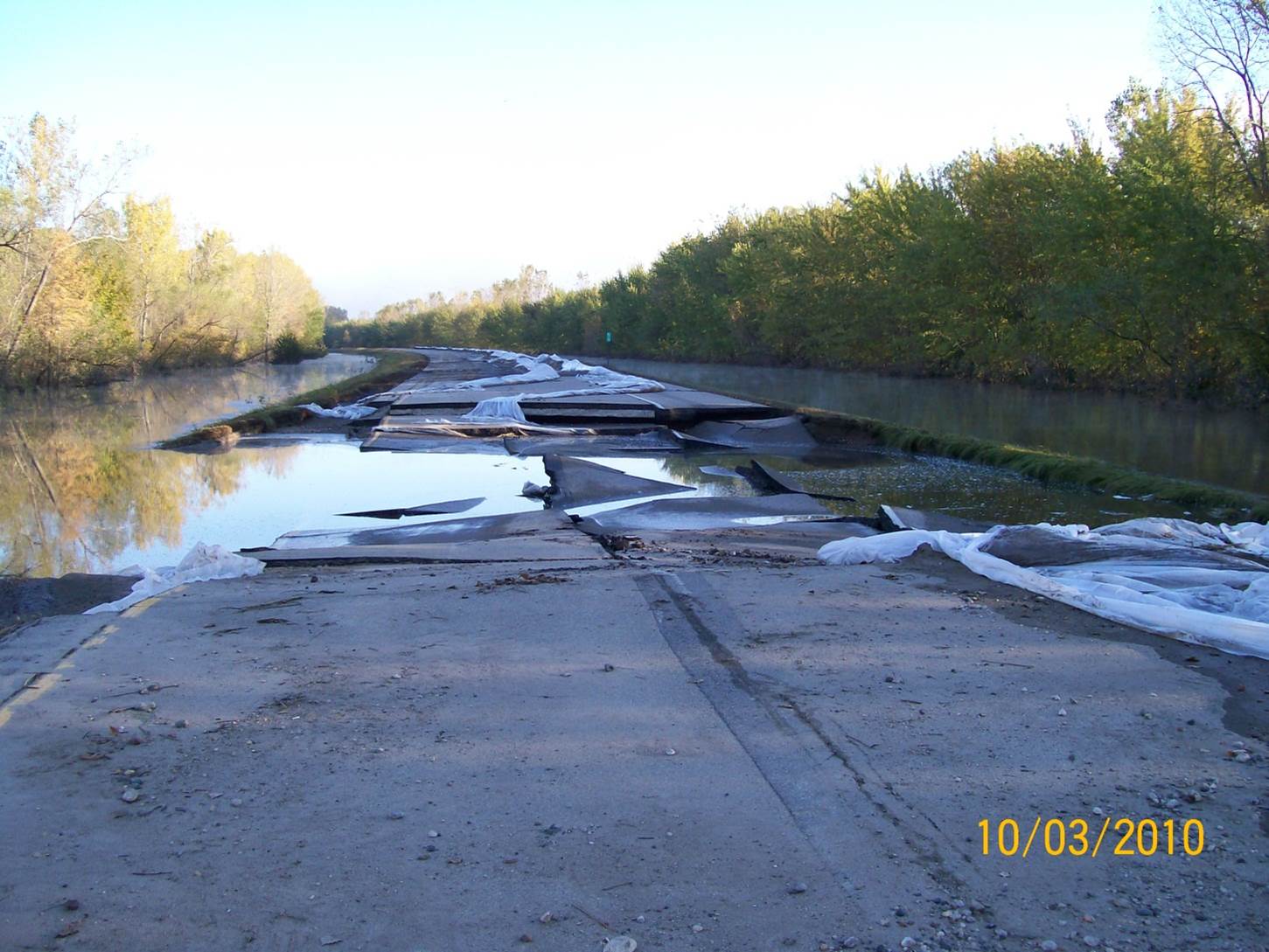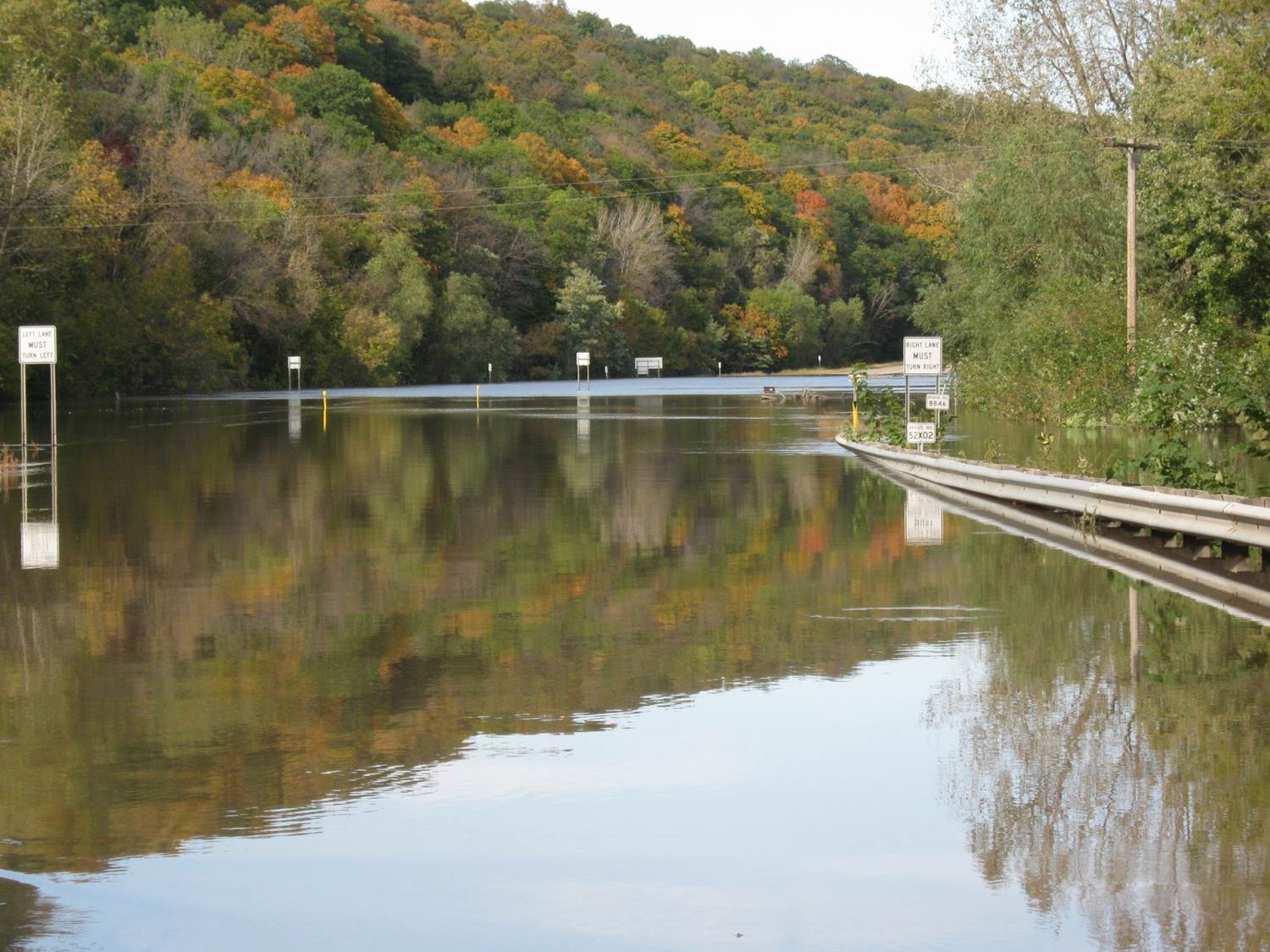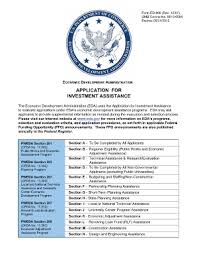
September 2015
In This IssueSubmit Your EDA Project Photos and Stories on 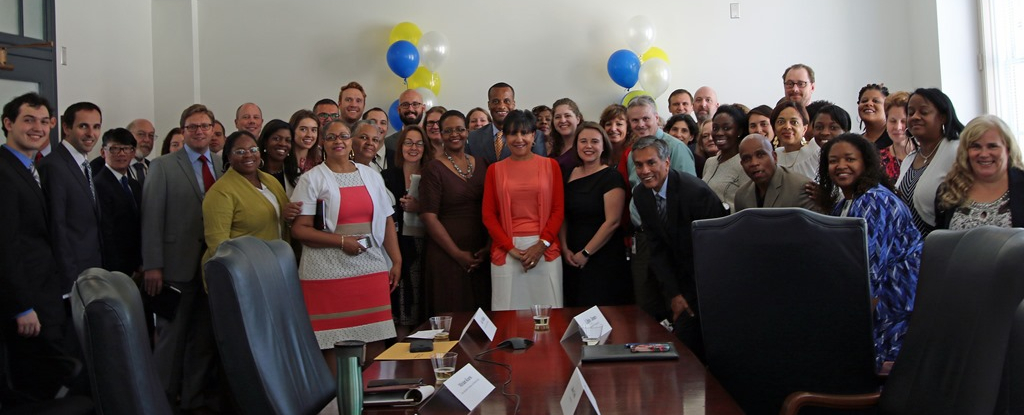 Secretary Pritzker with EDA staff for EDA’s 50th anniversary celebration
Success story: Raise the Road
Albert Einstein once said that “No problem can be solved from the same level of consciousness that created it.” The same wisdom can be applied when it comes to repairing flood damage to a road that has been built in the path of a flood plain. Sure, you can keep repairing the damage each time the flood waters recede, but that doesn’t leave you in any better position the next time it happens. Much like you have to raise your level of consciousness to solve a problem, you need to raise the level of the road out of the reach of flood waters. Minnesota ranks third in the nation for production of corn, soybeans and ethanol among all states. Counties located within Minnesota Department of Transportation (MNDOT) District 7 produce almost half of Minnesota's corn, soybeans and ethanol. The majority of the corn and soybeans grown in the district is shipped via truck to Mankato. From there the freight is shipped on U.S. Highway 169 to its final destinations. When U.S. Highway 169 in Minnesota kept flooding, resulting in disruptions to transportation, commerce, and daily life, it posed a major problem. Highway 169 serves the major transportation corridor for funneling freight within the region, but its proximity to the Minnesota River makes it prone to flooding in the spring as snow melts and river water rises. When these highways were originally constructed in the early 1960’s, water elevation assumptions for the area proved to be inaccurate. In late September and October of 2010, the river flooded and nearly 140 feet of highway collapsed, requiring that additional detours be created and emergency repairs be made. In May 2011, the road flooded again. In fact, there have been seven road closures due to flooding since 1993. The Region Nine Development Council (RNDC) recognized that something needed to be done. Repairing the road after flooding would just be a band-aid – a temporary solution that wouldn’t fix the underlying problem. The solution was to raise the road out of the reach of the flood waters, but it would be a massive undertaking and an expensive proposition. RNDC did some research and learned that EDA was offering disaster recovery grants. Highlight: Improvements to EDA Grant Application Processes
In April 2015, EDA issued a Federal Register Notice heralding some proposed improvements to our forms as part of overall enhancements we’re making to the grant application process. Very soon, those changes will become institutionalized. Here are a few key things you need to know to be ready when the FY2016 Public Works and Economic Adjustment Assistance Programs Federal Funding Opportunity hits the streets.
Why are we making these changes? EDA is continually seeking to improve our processes to make the applicant experience easier and the review process more efficient. This new process will ease the burden on applicants while enabling faster reviews by EDA staff. Spotlight: Looking for Innovative Ideas in New Places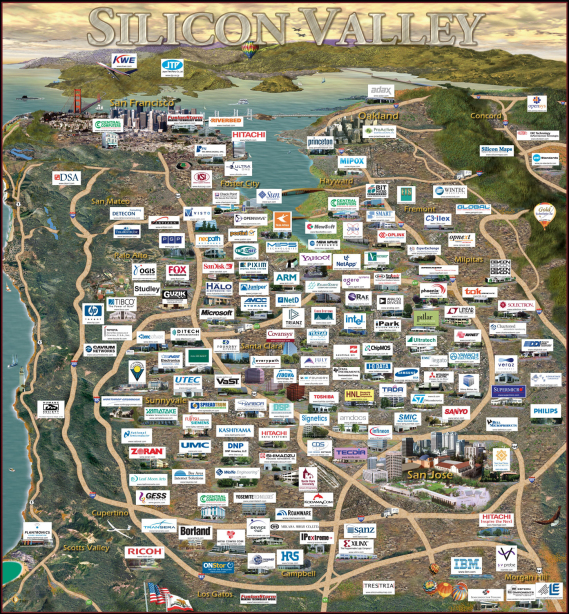 Map of tech companies in Silicon Valley. Photo credit / source: tellerallaboutit.wordpress.com
These days, there is a lot of talk about “innovation hubs.” When people think about innovation, many think about tech-heavy areas like Silicon Valley or Austin, Texas with young start-up CEOs in jeans and hoodies. Or they think of big cities like Boston and Atlanta where giant companies invest in research and development for the next scientific breakthrough. 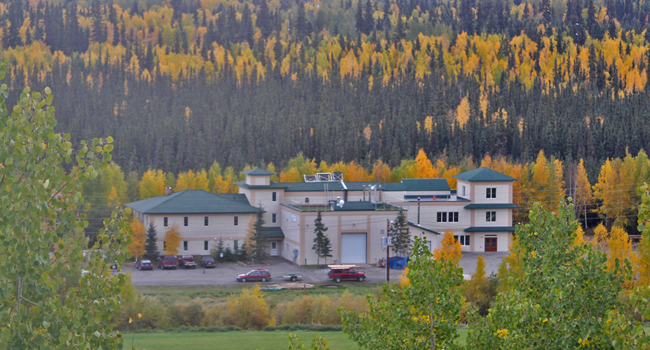 Cold Climate Housing Research Center in Fairbanks, Alaska
However, rural areas can also be centers of innovation – places like Alaska, where the Cold Climate Housing Research Center is revolutionizing how people can heat their homes efficiently in the Arctic Circle, where energy costs can be staggering. Necessity is the mother of invention, and necessity does not consider geographic boundaries or the divisions between urban and rural areas. This is why we are including a rural component to our 2015 Regional Innovation Strategies (RIS) Program and why we are asking applicants for outreach to underrepresented communities and populations in their regions. While innovation can happen anywhere, it still needs to be fostered and supported in order to take root. The Federal Funding Opportunity (FFO) for the 2015 RIS opened last month and offers i6 Challenge ($8 million) and Seed Fund Support Grants ($2 million) funding. For 2015, EDA is proud to announce that we expect awarding up to $2.5 million of the available $8 million under the i6 Challenge to organizations that offer services to rural areas. EDA has supported other rural challenges and projects in the past through public works funding or partnerships with USDA and others, and this anticipated RIS funding will build on those previous efforts to promote rural innovation. Furthermore, EDA will look at all programs’ plans to reach out to underrepresented communities and populations and to measure and track participation and other success metrics. |
||||||
|
|
|||
Manufacturing Extension Partnership to Hold Three Regional Forums in Advance of State CompetitionThe National Institute of Standards and Technology’s (NIST) Manufacturing Extension Partnership (MEP) intends to publish an announcement in January 2016 of funding availability for MEP Centers in the following twelve states: Alabama, Arkansas, California, Georgia, Louisiana, Massachusetts, Missouri, Montana, Ohio, Pennsylvania, Puerto Rico, and Vermont. Prior to the announcement of this federal funding opportunity (FFO), NIST MEP is conducting three regional forums in Boston, MA; San Francisco, CA and Atlanta, GA to provide interested entities more information about the MEP program, the state competition, and answer any questions regarding this funding announcement. For more information on the regional forums, please visit the MEP Competition site. Organize a Manufacturing Day Tour in Your CommunityManufacturing Day is Friday, October 2, 2015, and we need you to help recruit companies in your community to participate! This nationwide celebration of modern manufacturing is meant to inspire and welcome the next generation of manufacturers. Host companies at more than 2,000 sites across the nation will open their doors to show their communities that manufacturing is an innovative, technology-driven sector that provides stable, good-paying jobs. We want companies in your community to be part of this amazing grassroots movement. Whether through a plant tour for community partners or an open meeting with your organization’s leadership and elected officials, Manufacturing Day is a great way for you to increase public awareness of the manufacturing industry. Visit www.mfgday.com to register your organization’s Manufacturing Day event and find tools and tips to help you execute your Manufacturing Day event. Be sure to check out the Manufacturing Day Host Toolkit to see all the best practices and sample ideas that will help you plan a great event and the Community Planning Guide designed for any organization interested in facilitating the creation of events or attendance at events in a region. New Comprehensive Economic Development Strategy Content Guidelines Webinar SeriesThis month, join the NADO Research Foundation for a three-part webinar series that will take a deeper dive into the recent revisions to EDA’s Comprehensive Economic Development Strategy (CEDS) Content Guidelines. The Guidelines suggest how to develop the document’s format and substance to make the strongest, most useful and effective CEDS possible – a true roadmap and driver of regional economic resilience. Building more resilient communities starts with better planning – planning that is comprehensive, forward-thinking, and goal-oriented. The dates and topic are below. Click on the name of the webinar for more information or to register:
Mark Your Calendar: 2nd IMCP SummitOct 21-22, the Department of Commerce, EDA, and our federal partners will host the second Investing in Manufacturing Communities Partnership (IMCP) Summit. Building on the success of the first summit held last October, designated communities, applicants, and other interested partners and stakeholders will convene in Washington, DC to share best practices and learn from one another’s experience in building effective partnerships to grow their communities’ manufacturing sectors. Keep watching for more details and registration information. EDA Announces Nearly $1.4 Million to Support Workforce Development in Brenham, TXOn Aug 31st, Assistant Secretary Jay Williams was in Brenham, Texas, home of “Blue Bell” ice cream, to announce a $1.4 million EDA grant to build a workforce and technical training center. According to the grantee, this project will attract new business to the area and enable existing industries to upgrade technology and processes, which could have long-term potential to create jobs for the region. Check out press coverage of the announcement, which coincided with the return of local favorite Blue Bell ice cream to shelves:
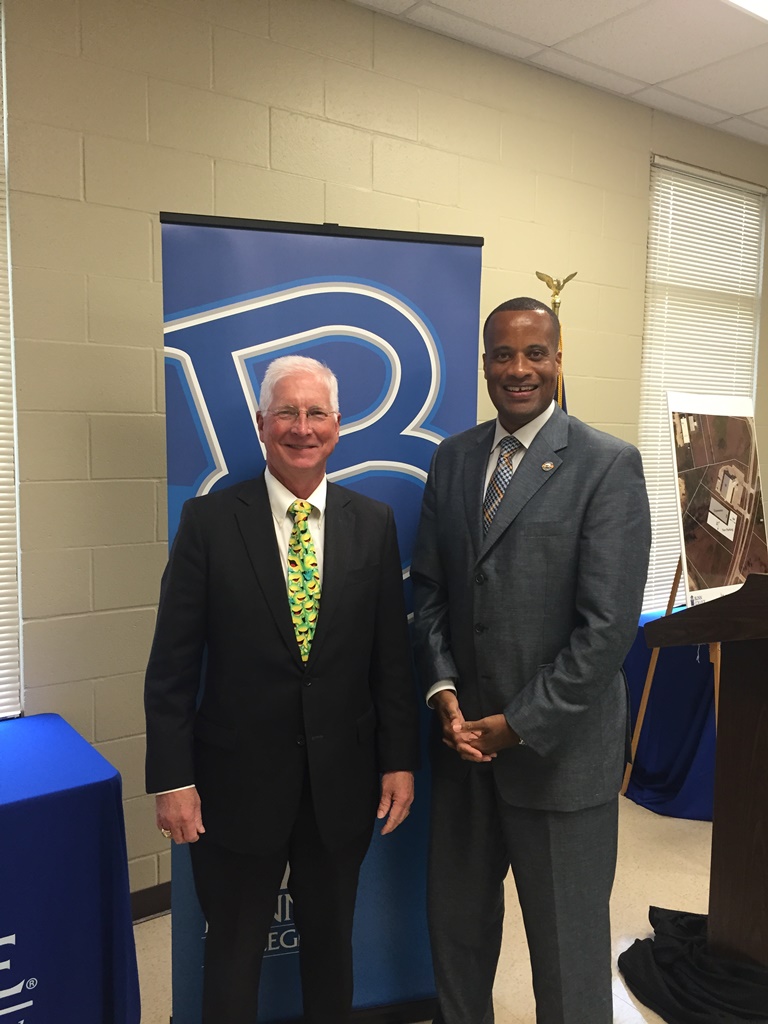 Assistant Secretary Williams with Blue Bell CEO and President Paul Kruse
EDA and Commerce Commemorate 10 Years since Hurricane KatrinaOn August 27, Deputy Assistant Secretary Matt Erskine traveled to New Orleans to announce $2.1 million in grants to support resiliency and economic growth in the Gulf Region. Additionally, DAS Erskine announced a new partnership between EDA and the Delta Regional Authority (DRA) to promote resiliency and training throughout the region and joined representatives from the DRA and the International Trade Administration for a roundtable discussion about promoting economic development and international trade with leaders in the Delta Region. EDA is proud to have been, and to continue to be, a partner to the entire region as it rebuilds its economy stronger, bigger, and better. |

